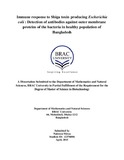Immune response to shiga toxin producing Escherichia coli : detection of antibodies against outer membrane proteins of the bacteria in healthy population of Bangladesh
Abstract
Escherichia coli O157:H7, a serotype of Shiga toxin producing E. coli (STEC) is responsible for numerous food and waterborne outbreaks more reported in industrialized countries than from developing countries. Until recently, no outbreak has been reported in Bangladesh nevertheless of their prevalence in the environment. Therefore, the hypothesis of possible immunity present in the healthy population in Bangladesh need to be investigated. As outer membrane proteins (omp) of E. coli O157:H7 act as important components to stimulate the immune response during infection, the present study has been focused on investigating immune response in healthy human sera against outer membrane proteins of E. coli O157:H7 isolated and characterized for stx 1 and stx 2 positive from local bovine feces and comparing with reference clinical strain of E. coli O157:H7 as well. Previously isolated and characterized strains are re confirmed using simple biochemical tests for E. coli. Crude protein extraction is carried out using simple sds-lysis and extraction of outer membrane proteins are performed by using Tris-sucrose-EDTA (TSE) buffer. For both crude extract and omps, proteins are characterized by SDS-PAGE assay where a prominent band of molecular weight 45 kDa is obtained for both vegetables and bovine isolates. Western blot experiment showed similar band pattern of 45 kDa in 48 randomly collected healthy human sera accompanied by ELISA with different dilutions and one positive and negative control. This prominent band of molecular weight 45 kDa has been obtained indicating its role as an immunogen. Further, ELISA was performed on 336 randomly collected healthy human sera where it clearly indicates the high level of immunogenic response against outer membrane proteins is present in all tested human sera indicating the presence of acquired immunity in this particular population against the outer membrane proteins. All these data strongly suggest the immunogenic role of ~45 kDa outer membrane protein of E. coli O157:H7 and the evidence that immunity against this protein is present in human sera of Bangladesh. This study could explore a new insight in the field of immunology and vaccine development and highly demands for further study in vivo.

